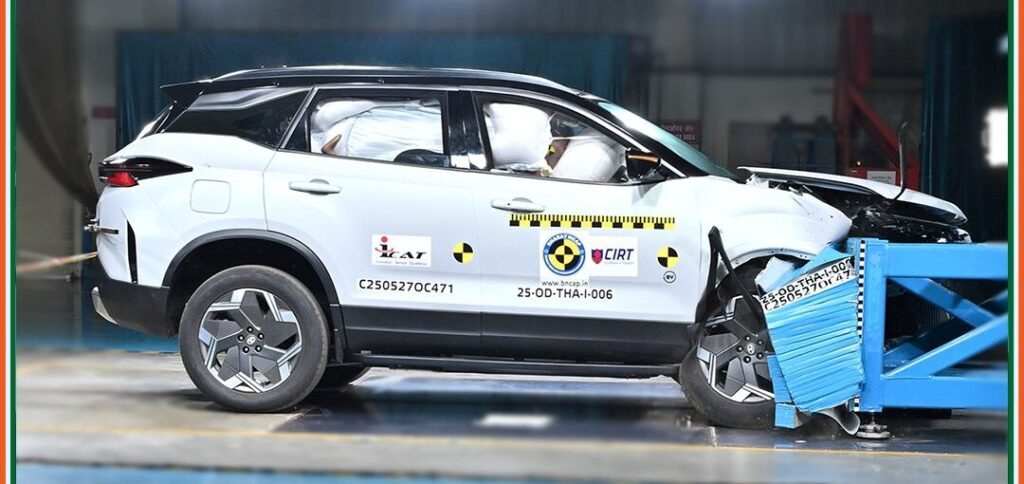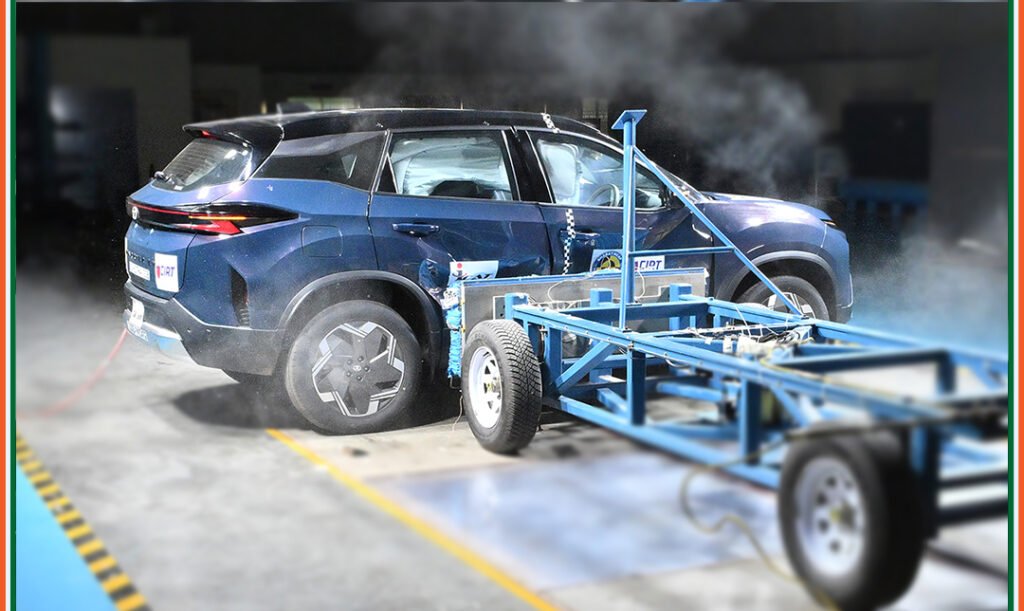Harrier EV crash test results are out! Tata’s electric SUV scores a 5-star BNCAP safety rating. Learn what makes the Harrier EV India’s safest electric SUV in 2025.
Harrier EV crash test results have officially been released by Bharat NCAP (BNCAP), and the outcome is a huge win for Tata Motors. The electric SUV has scored an impressive 5-star rating, making it one of the safest EVs in India. This milestone reaffirms Tata’s growing reputation for building structurally strong and safety-focused vehicles—even in its electric lineup.
The crash test results were published under the Bharat New Car Assessment Programme (BNCAP), which is India’s official vehicle safety benchmark introduced to align with global standards.
Tata Harrier Crash Test Rating: What the Scores Reveal
According to BNCAP’s evaluation:
-
- Adult Occupant Protection (AOP): 32/32
-
- Child Occupant Protection (COP): 45/49
These scores translate to a 5-star crash test rating, validating the Harrier EV’s structural integrity, airbag performance, and advanced safety features. The Tata Harrier EV crash test rating now places the SUV in the top tier of Indian EV safety, matching the best from both domestic and global players.

Image Courtesy: bncap.in
EV Safety Elevated: Tata Leads the Pack
The Harrier EV is the latest model in Tata’s portfolio to receive top safety honors. With India moving towards electrification, Tata EV crash test results like these are vital in building consumer trust. Safety has emerged as a top priority, especially for families transitioning from ICE to EVs.
In fact, Tata’s growing EV family — including the Nexon EV and Punch EV — is setting new standards, and the Harrier EV’s 5-star BNCAP rating only adds to this momentum.
Advanced Safety Features That Made It Possible
The Harrier EV comes with a host of standard and optional safety features that helped it secure a top crash test rating:
-
- Six Airbags Standard: Offering extensive protection to all occupants
-
- Electronic Stability Control (ESC): Prevents skidding and maintains control during sudden maneuvers
-
- Three-point Seatbelts & Reminders: For all passengers
-
- ISOFIX Anchor Points: For safe and secure child seat installation
-
- Strong Body Structure: Built on the Acti.ev+ platform
-
- Front and Side Crash Protection: Specially engineered to protect both battery and passengers
These features not only comply with but exceed Indian regulatory safety requirements, showcasing Tata’s commitment to holistic crash protection.

Image courtesy: bncap.in
The Harrier EV crash test report highlighted:
-
- Stable body shell performance in frontal offset and side impact tests
-
- Low intrusion into the cabin area
-
- Well-tuned restraint systems for both adult and child occupants
-
- ISOFIX anchors for child seats and optional ADAS features in higher trims
EV-Specific Crash Considerations
Crash testing an electric vehicle poses additional challenges—especially when it comes to battery pack safety and high-voltage isolation. The Harrier EV successfully passed these evaluations with flying colors.
The battery enclosure demonstrated resistance to deformation and fire risk. Emergency shutoff systems also activated as expected, disconnecting the electrical system to prevent post-collision hazards.
The Harrier EV crash test confirms that Tata has built an EV that’s not only eco-conscious but also extremely safe, addressing key concerns about battery safety during collisions.

Image courtesy: bncap.in
BNCAP’s Role in Elevating Vehicle Safety in India
The Bharat New Car Assessment Programme was introduced to promote transparency in vehicle safety ratings. Similar to Global NCAP but adapted for Indian driving conditions, BNCAP evaluates:
-
- Frontal offset crashes at 64 km/h
-
- Side impact performance
-
- Child occupant protection using crash test dummies and car seats
-
- Safety assistance features like ESC, seatbelt reminders, etc.
Tata Motors has been an active participant in this initiative and the Tata Harrier crash test rating under BNCAP is yet another feather in its cap.
Tata’s Growing Reputation for Safety
This isn’t the first time Tata has received accolades for its crash-worthy vehicles. In recent years, models like the Nexon, Punch, Altroz, and Tigor EV have all achieved 4-star or 5-star ratings in Global NCAP or BNCAP assessments.
The Harrier EV in the Bigger Picture
The Harrier EV is more than just another electric SUV; it’s a flagship product designed to showcase Tata’s advancements in design, platform versatility, and now—confirmed safety. Built on the Acti.ev+ architecture, the SUV features futuristic styling, a spacious cabin, and next-gen technology.
The Harrier EV will play a key role in Tata’s long-term electrification strategy. It also represents a shift toward mainstream EVs that don’t compromise on performance or safety.
Now with a 5-star crash test rating, the Harrier EV offers not just environmental benefits but also peace of mind. For families, and urban professionals considering an electric SUV, safety is no longer a compromise.
Conclusion: A Win for Tata and Indian EV Buyers
The 5-star Tata Harrier crash test rating by BNCAP sets a new benchmark for electric vehicle safety in India. With this, Tata has not only raised the bar for competitors but has also given EV buyers a solid reason to trust electric mobility.
The Harrier EV crash test confirms that safety and sustainability can—and must—go hand in hand. As India moves towards an electric future, vehicles like the Harrier EV will play a pivotal role in reshaping consumer expectations around quality, safety, and performance.

